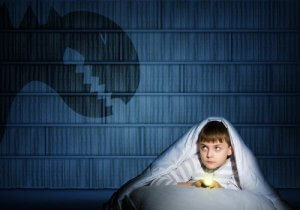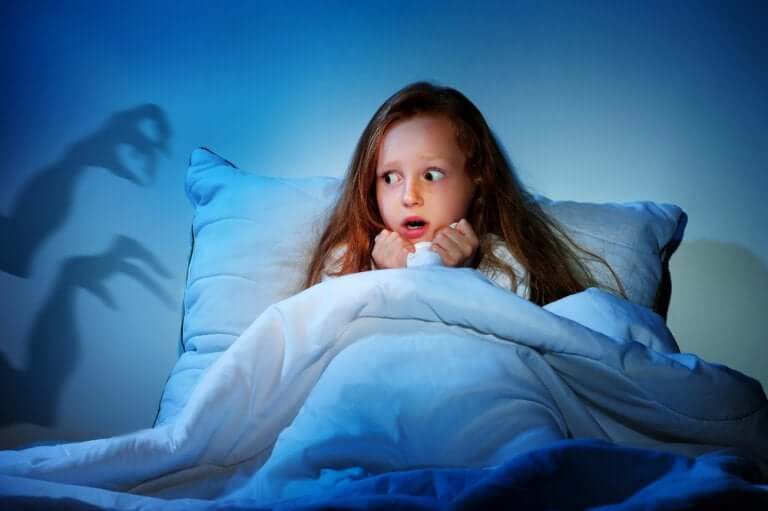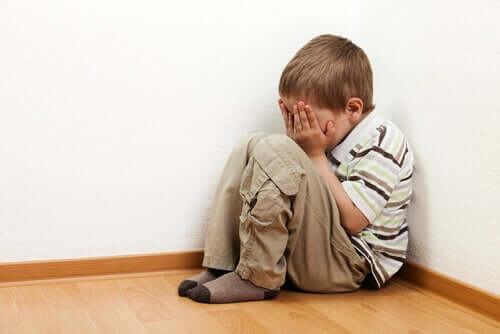Learn How to Channel Childhood Fears


Written and verified by the psychologist María Alejandra Castro Arbeláez
Despite being such a natural emotion, fear is still a mystery in many ways. This is especially the case for parents with children who often feel fear, despite being in a safe environment like home. We can help to channel childhood fears once we understand that fear is a necessary emotion in our lives.
Fear, a basic emotion
Fear, like joy, anger, sadness, surprise and disgust, is a basic human emotion, regardless of culture or ethnicity. Each emotion has its function, and, in the case of fear, it’s very clear: the function is survival. Without fear, the human species would have become extinct from day one. Fear acts as an adaptive mechanism to guard against dangers.
But why do children have so many fears? According to psychiatrist Christophe André, the answer is simple. He says that it’s normal for children to have lots of fears, due to their fragility. As we mentioned earlier, fear is a survival mechanism, so the more fragile a living being is, the more useful fear is to them.
Another perspective of fear is as insecurity in the face of the unknown. According to Montse Domenech, this insecurity shows itself in the form of fear when a child has no control over new situations. They haven’t yet learned to apply methods to cope with those situations, and to find ways of feeling more secure.
“Fear cultivates fear.”
– Byron Janis –
Dysfunctional fears
Fear can be a problem when it becomes dysfunctional and leads to more complex emotions, such as anxiety and distress, or pathological ones, such as phobias.

Christophe André points out that understanding how exaggerated fears work is an essential precursor to “healing.” Once you’ve understood the fear process, you can begin to de-dramatize, de-stigmatize, and explain the fears.
This is why, in his consultations, he explains the mechanism of fear to his patients. This helps them to get out of the vicious circle of guilt and useless questions, such as “Am I to blame for what’s happening to me?” in order to lead them towards the functional: “What can I do today?”
How to channel childhood fears
Fears in children are many and varied. They can be unreal, like the fear of monsters, or they can be very real, like the fear of the dark or fear of their parents’ death. Keep reading and learn how to help your children channel their fears.
- Accept fear as a necessary emotion. Explain to your children what basic human emotions are and why each one is necessary. To do this, you can watch the animated film Inside Out together, which shows how all our basic emotions work.
- Detecting fear and understanding it. The first step is to recognize fear. You mustn’t ignore it or dismiss it. Once it’s been identified, talk to your child about it. Use soothing words to help calm and comfort your child.
- Know your fears and rationalize them. If these are real fears, it’s best to rationalize them and help your child understand them by talking about them or through stories. On the contrary, if they’re unrealistic fears, explain to them that their monsters don’t exist, and that they’re perfectly safe. The important thing is for them to not feel alone in all of this, and that you’re with them.
- Confront the fear. Distraction can help to relieve a child’s fears, but at some point they must be confronted. If we don’t help children face their fears, those fears will remain. It’s important to do this slowly. If not, then we run the risk of creating the opposite effect, and making our child too aware of their fears.
- Reduce the number of warning messages. Parents, whether voluntarily or not, alert their children to possible risks and dangers. However, continuously alerting the child can feed exaggerated fears. Today, parents still often talk about the bogeyman, or something similar, not realizing how traumatic this can be for children.

Conclusions on how to channel childhood fears
Recognizing and accepting fear as a necessary basic emotion is the first step in helping to channel a child’s fears. Children must accept it in a healthy way and learn to handle it as efficiently as possible.
In short, it’s not a question of trying to control all the mental processes that fear can trigger. The reason for this is that fear is a necessary “alarm” that our bodies send us. What a child needs to learn is how to use it to adapt to life’s circumstances. Undoubtedly, channeling fears in children will help them to understand themselves better and, in time, they’ll learn to deal with them better and better.
Despite being such a natural emotion, fear is still a mystery in many ways. This is especially the case for parents with children who often feel fear, despite being in a safe environment like home. We can help to channel childhood fears once we understand that fear is a necessary emotion in our lives.
Fear, a basic emotion
Fear, like joy, anger, sadness, surprise and disgust, is a basic human emotion, regardless of culture or ethnicity. Each emotion has its function, and, in the case of fear, it’s very clear: the function is survival. Without fear, the human species would have become extinct from day one. Fear acts as an adaptive mechanism to guard against dangers.
But why do children have so many fears? According to psychiatrist Christophe André, the answer is simple. He says that it’s normal for children to have lots of fears, due to their fragility. As we mentioned earlier, fear is a survival mechanism, so the more fragile a living being is, the more useful fear is to them.
Another perspective of fear is as insecurity in the face of the unknown. According to Montse Domenech, this insecurity shows itself in the form of fear when a child has no control over new situations. They haven’t yet learned to apply methods to cope with those situations, and to find ways of feeling more secure.
“Fear cultivates fear.”
– Byron Janis –
Dysfunctional fears
Fear can be a problem when it becomes dysfunctional and leads to more complex emotions, such as anxiety and distress, or pathological ones, such as phobias.

Christophe André points out that understanding how exaggerated fears work is an essential precursor to “healing.” Once you’ve understood the fear process, you can begin to de-dramatize, de-stigmatize, and explain the fears.
This is why, in his consultations, he explains the mechanism of fear to his patients. This helps them to get out of the vicious circle of guilt and useless questions, such as “Am I to blame for what’s happening to me?” in order to lead them towards the functional: “What can I do today?”
How to channel childhood fears
Fears in children are many and varied. They can be unreal, like the fear of monsters, or they can be very real, like the fear of the dark or fear of their parents’ death. Keep reading and learn how to help your children channel their fears.
- Accept fear as a necessary emotion. Explain to your children what basic human emotions are and why each one is necessary. To do this, you can watch the animated film Inside Out together, which shows how all our basic emotions work.
- Detecting fear and understanding it. The first step is to recognize fear. You mustn’t ignore it or dismiss it. Once it’s been identified, talk to your child about it. Use soothing words to help calm and comfort your child.
- Know your fears and rationalize them. If these are real fears, it’s best to rationalize them and help your child understand them by talking about them or through stories. On the contrary, if they’re unrealistic fears, explain to them that their monsters don’t exist, and that they’re perfectly safe. The important thing is for them to not feel alone in all of this, and that you’re with them.
- Confront the fear. Distraction can help to relieve a child’s fears, but at some point they must be confronted. If we don’t help children face their fears, those fears will remain. It’s important to do this slowly. If not, then we run the risk of creating the opposite effect, and making our child too aware of their fears.
- Reduce the number of warning messages. Parents, whether voluntarily or not, alert their children to possible risks and dangers. However, continuously alerting the child can feed exaggerated fears. Today, parents still often talk about the bogeyman, or something similar, not realizing how traumatic this can be for children.

Conclusions on how to channel childhood fears
Recognizing and accepting fear as a necessary basic emotion is the first step in helping to channel a child’s fears. Children must accept it in a healthy way and learn to handle it as efficiently as possible.
In short, it’s not a question of trying to control all the mental processes that fear can trigger. The reason for this is that fear is a necessary “alarm” that our bodies send us. What a child needs to learn is how to use it to adapt to life’s circumstances. Undoubtedly, channeling fears in children will help them to understand themselves better and, in time, they’ll learn to deal with them better and better.
All cited sources were thoroughly reviewed by our team to ensure their quality, reliability, currency, and validity. The bibliography of this article was considered reliable and of academic or scientific accuracy.
- André, C. (2005). Psicología del miedo. Temores, angustias y fobias. Editorial Kairós. España: Barcelona
- Domenech, M. (2017). La vacuna contra el miedo. Editorial De Bolsillo. España
This text is provided for informational purposes only and does not replace consultation with a professional. If in doubt, consult your specialist.








